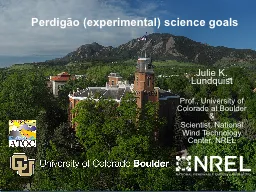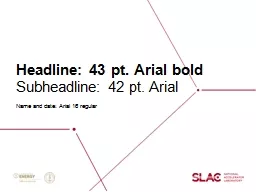PPT-Headline
Author : natalia-silvester | Published Date : 2017-01-28
Perdigão experimental science goals Julie K Lundquist Prof University of Colorado at Boulder amp Scientist National Wind Technology Center NREL 1 Multiscale flow
Presentation Embed Code
Download Presentation
Download Presentation The PPT/PDF document "Headline" is the property of its rightful owner. Permission is granted to download and print the materials on this website for personal, non-commercial use only, and to display it on your personal computer provided you do not modify the materials and that you retain all copyright notices contained in the materials. By downloading content from our website, you accept the terms of this agreement.
Headline: Transcript
Perdigão experimental science goals Julie K Lundquist Prof University of Colorado at Boulder amp Scientist National Wind Technology Center NREL 1 Multiscale flow interactions Whenhow are the flow structures in the valley impacted by local thermal circulation for a given incident flow How do the slope and valley flows . templates. . FOR . CREATING SHAREABLE GRAPHICS ON . social media. .. 17. Many marketers understand the need for social media. But once you’re using this channel, are you using it to the best of its ability? . Michael . O’Brien 530.921.2435 . enjoymichaelobrien.com. 6 Key Societal Forces All Marketers Must Understand :. Customers are:. Extremely cynical. Bombarded with too many offers. ; . Writing effective headlines. | . Good headlines. . Home. | . Assignment list. . . What is needed?. Potential witness to murder drunk . What is needed here?. Dole and Bush dead even in Kansas polls. Writing Basics. 1-line-headline. Bricklayers engage in mortar combat. 2-line-headline. Backers hot for chili. as U.S. official food. 3-line-headline. Mosquitos. biting into. holiday fun. Hammer - main/secondary . Offline and Online. Robin Riggs, . Robbinskersten. Direct. September 14, 2015. Why is this so important. ?. We know donors get this far and respond or not. . - Biggest test results since softening. - Every inch is critical real estate!. J. oint U.S. National Academy of Science and Royal Society 20-point summary: . 20. Q/As. to follow this slide. J. oint U.S. National Academy of Science and Royal Society 20-point summary: . 1: THE CLIMATE IS WARMING. cutlines. Limelight. Headlines. A headline is the “title” of an article.. It appears at the top of an article.. Ex. Limestone takes next step. Man arrested in wife’s death. How to write headlines. Mrs. . Antey – . US Government Unit 3. Last video: . Constitutional Convention. Delegates to the . Constitutional Convention. Independence Hall 1787. The Preamble is the . Introduction. to the Constitution. Slide headline . Solving for Today. Preparing for Tomorrow. . Your phone has been automatically muted. Please use the Q&A panel to ask questions during the presentation!. Slide headline . © 2016 Galen Healthcare Solutions. Title. Company. Speaker Name. One Column Content. We utilize bullet level one as plain text because. it’s meant to be written in paragraph form.. Here we insert our first bullet. Try to keep bullets short and to a minimum. Title. Line of copy in here for you to change. Whatever you are going to type goes in here.. Line of copy goes . here . Line of copy goes here. Line of copy goes . here . Line of copy goes here. Line . Institution. Date. Replace this box with key image to introduce talk’s scope, importance, or background. Replace with . your Logo. Title of Presentation in Initial Capitals:. 36 Points, Calibri Bold. PE – Understand the use of an advertisement’s components to communicate with targeted audiences. PI - Explain Components of Advertising. Why advertise?. Advertisements all aim to:. Attract attention. Name and date: Arial 16 regular. Subheadline. : 42 pt. Arial. 2. SLAC National Accelerator Laboratory. Our mission:. Grow into a premier photon science laboratory. Maintain our position as the premier accelerator laboratory.
Download Document
Here is the link to download the presentation.
"Headline"The content belongs to its owner. You may download and print it for personal use, without modification, and keep all copyright notices. By downloading, you agree to these terms.
Related Documents














